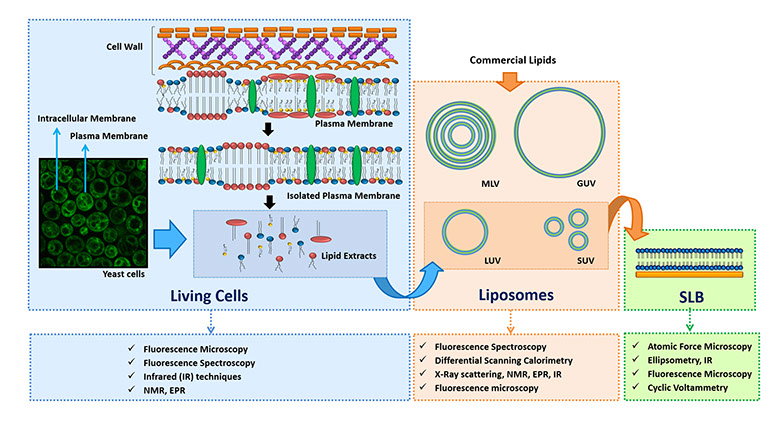Research topics
Molecular interactions in biomembranes: the roles of membrane biophysical properties in health and disease
Biological membranes are organized into (micro)domains consisting of regions with different lipid and protein composition, properties and functions. Furthermore, several pathologies, including cancer and neurodegenerative conditions, are characterized by specific alterations in lipid composition and hence membrane biophysical properties. Moreover, the molecular mechanism of action of many drugs involves at some point their effect on membrane lipid organization (the membrane-lipid therapy principle). Thus, fundamental research on membrane domains in both physiological and pathological situations will take place in parallel with the study of compounds that can potentially promote health and prevent functional decline. Several molecular biophysical approaches will be used to tackle the complex interactions between these agents and biomembranes, proteins and DNA, with potential benefits for society, in alignment with the thematic line "Human health: Molecular Interventions and Regulation Mechanisms".
Development of synthetic transporters with potential to change membrane ion transport properties of biomembranes in vivo
Ion transport across cell membranes is essential to several biological processes, from energy transduction to neurotransmission. A combination of protein ion channels embedded in cell membranes controls ion concentrations in the different sub-cellular compartments. Dysfunctions in these channels are currently linked to certain pathologies, such as cystic fibrosis, caused by a defective transport of chloride anions, and learning and memory disabilities, such as in Alzheimer’s disease (AD). Therefore, synthetic transporters will be designed and tested envisaging possible replacement therapeutics for malfunctioning channels.
Several of these compounds have also anticancer activity which will be primarily assessed with cytotoxicity studies using cancer cell lines.
Our main approaches
We aim to develop and characterize lipid domains and rafts membrane model systems that mimic biomembrane properties in an increasingly reliable manner. We intend to understand the organization of the lipid micro and nanodomains in membrane extracts, purified cell membranes and finally in cell membranes (yeasts and mammalian cell lines). In particular, we are interested in membrane-related molecular mechanisms important for human health and fungi resistance to antibiotics.
The characterization of model and cellular membranes is made by optical spectroscopic and microscopic techniques (steady-state and time-resolved fluorescence, FRET, fluorescence anisotropy, fluorescence quenching, fluorescence microscopy). We are also using surface techniques for the controlled formation and characterization of lipid bilayer films in collaboration with the Interfacial Electrochemistry group: atomic force microscopy (AFM); cyclic voltammetry; ellipsometry.
Molecular Biophysics

Synthesis and NMR spectroscopy
State-of-the art synthetic approaches are used to obtain a library of synthetic membrane anion carriers, taking into account structure-activity relationships (SAR) on desired biological properties for drug design. NMR spectroscopy, MS and crystallography are used to obtain the structure of the synthesized compounds. The anion binding ability will be evaluated through NMR titrations.
Cell culture and microbiology
Yeast (Saccharomyces cerevisiae) and filamentous fungi (Neurospora crassa) are our favorite model organisms to study membrane biophysical properties and lipid domain organization in vivo, as well as their biological roles and involvement in fungicide mode of action.
Several animal cell lines are used to study membrane lipids and cytotoxicity of different compounds.
Departamento de Química e Bioquímica
Faculdade de Ciências da UL
Molecular Biophysics Lab.
Campo Grande, Ed. C8 Piso 4
1749-016 Lisboa, Portugal
